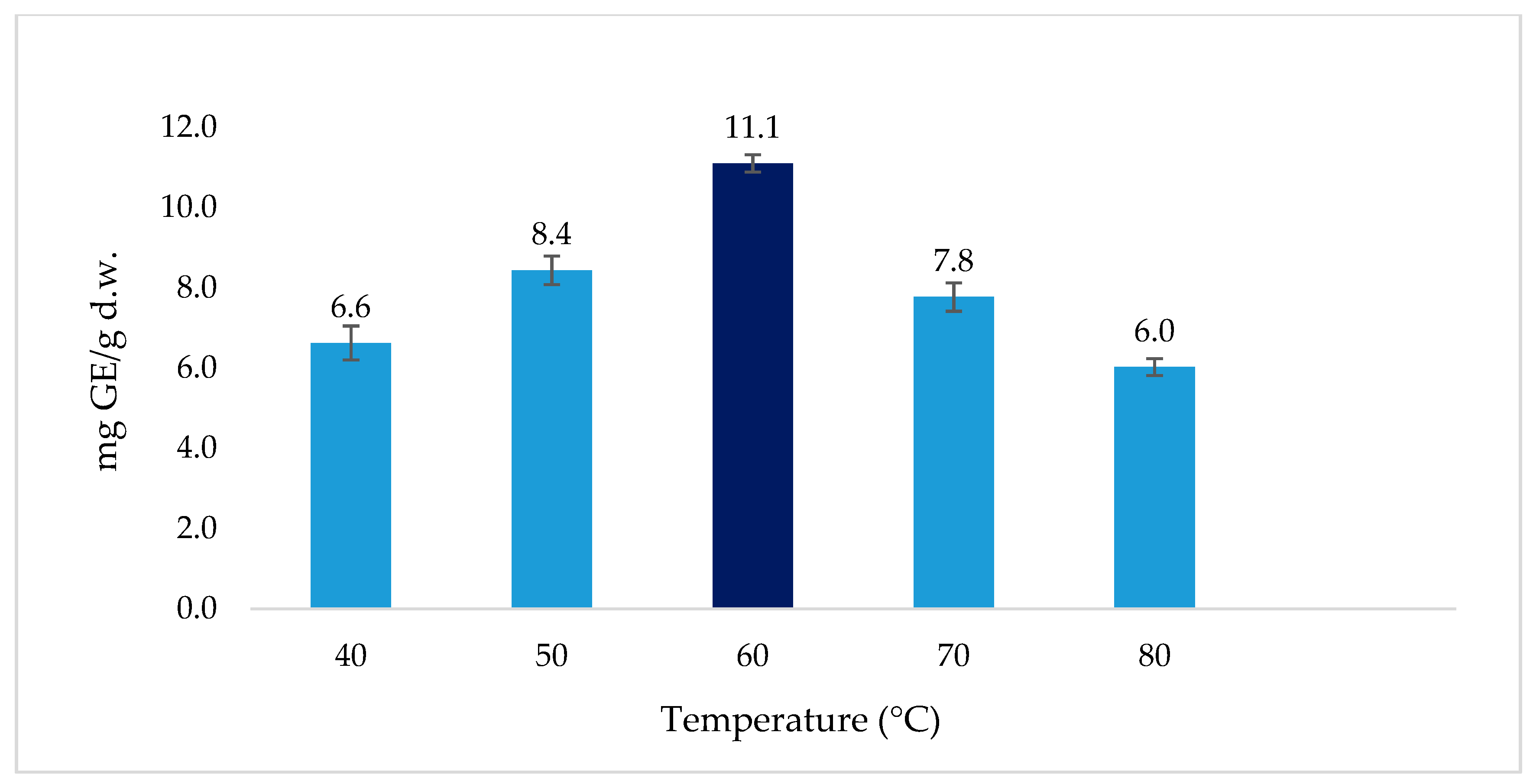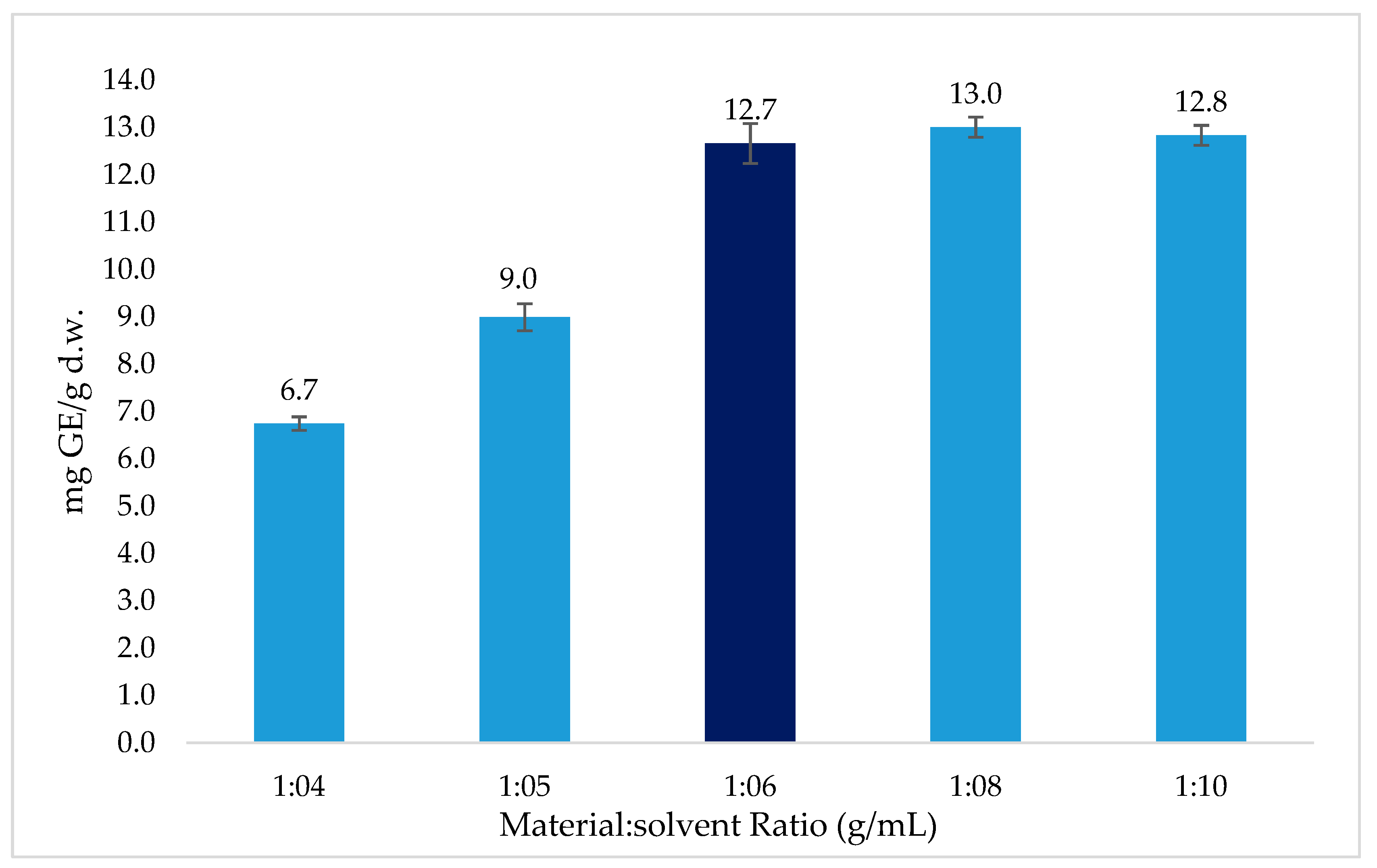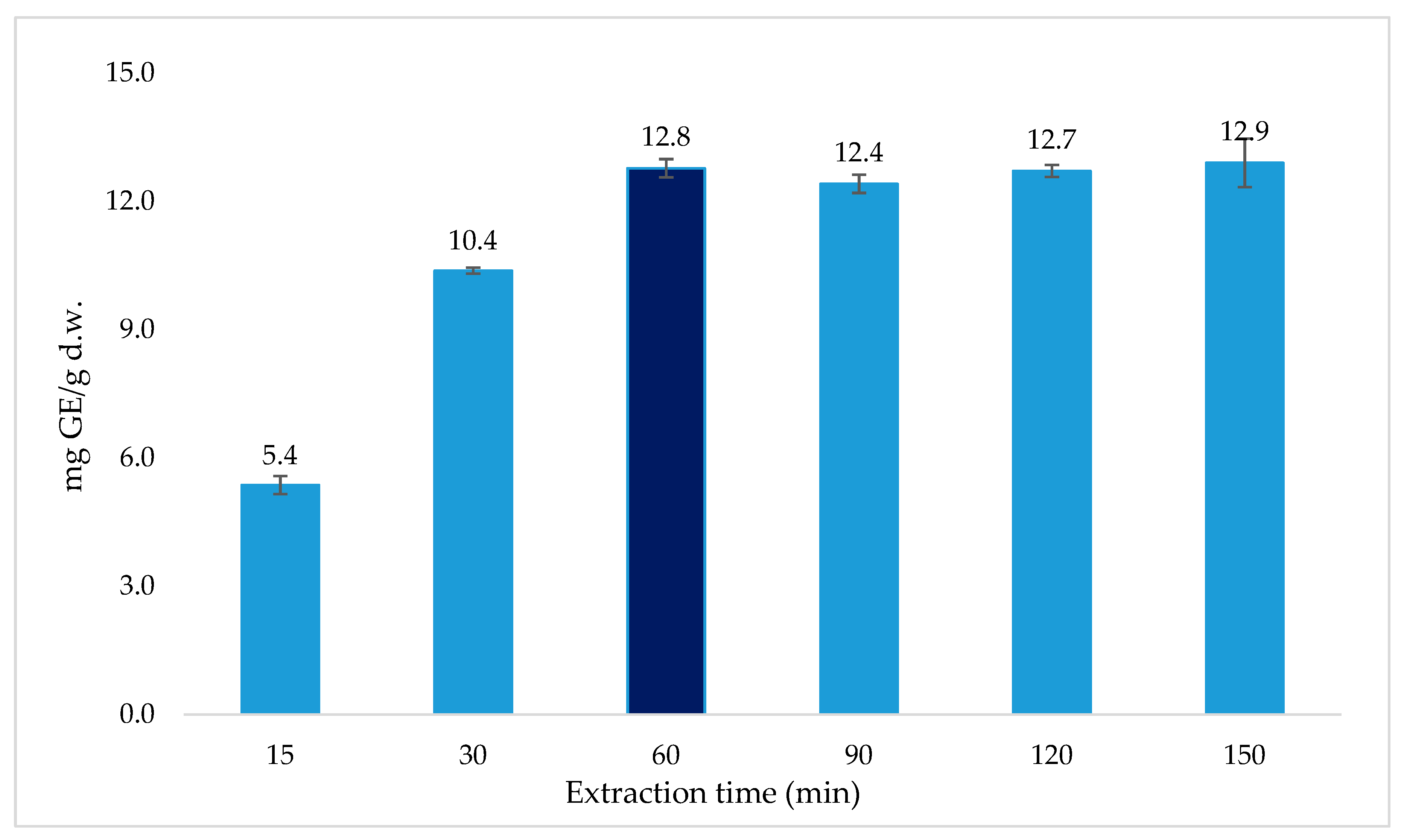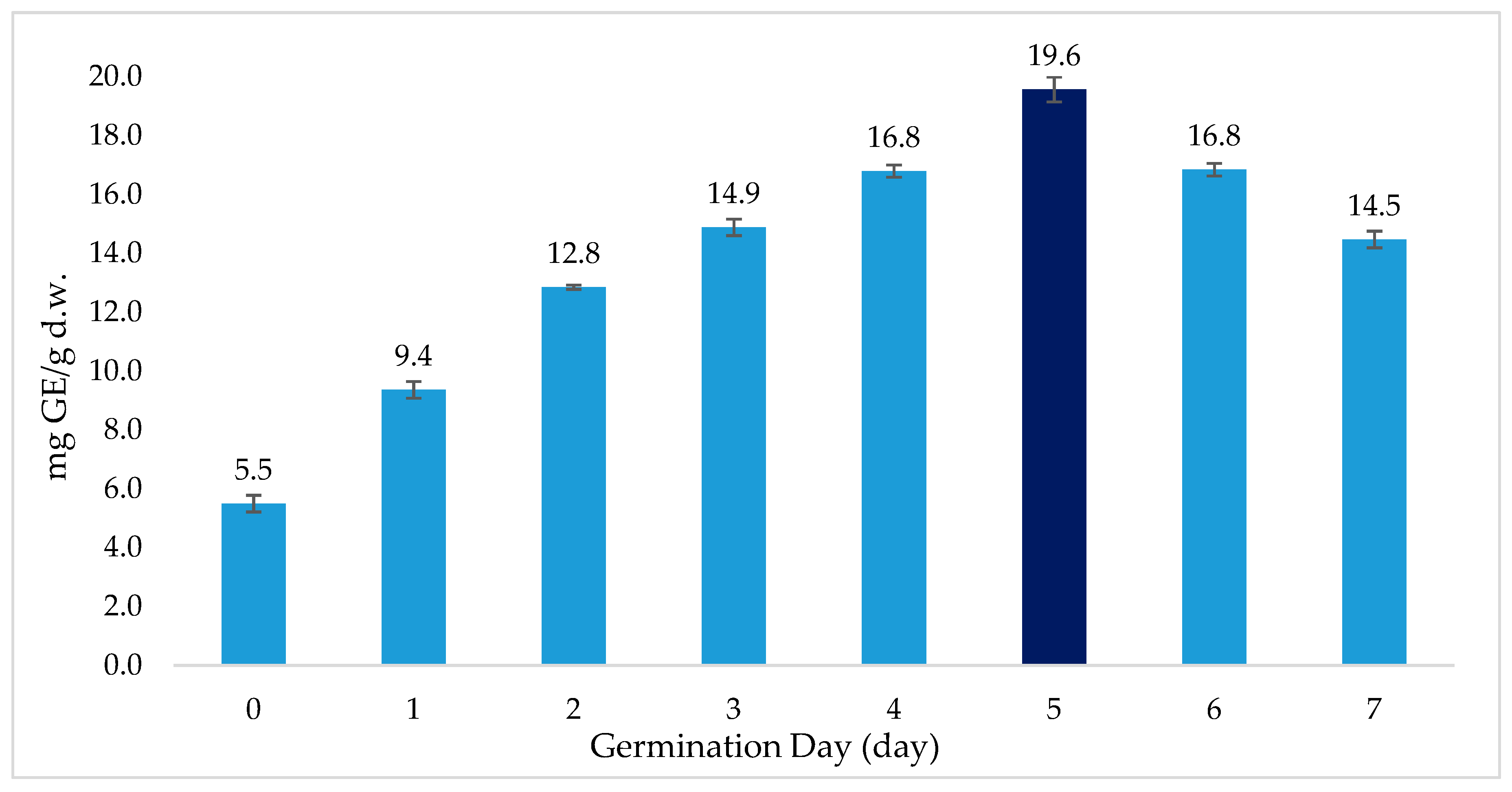Extraction Process of Polyphenols from Soybean (Glycine max L.) Sprouts: Optimization and Evaluation of Antioxidant Activity
Abstract
:1. Introduction
2. Materials and Methods
2.1. Plant Sample Preparation
2.2. Extraction Method
2.3. Optimization of Extraction Process by Response Surface Methodology (RSM)
2.4. Quantification of Total Polyphenol Content (TPC) Based on Folin-Ciocalteu (FC) Methodology
2.5. Antioxidation Evaluation with 1,1-Diphenyl-2-Picrylhydrazyl (DPPH)
2.6. Instruments
3. Results and Discussion
3.1. Single-Factor Investigations with Regard to TPC
3.1.1. Influence of Ethanol Concentration
3.1.2. Influence of Extraction Temperature
3.1.3. Influence of Material:Solvent Ratio
3.1.4. Influence of Extraction Time
3.1.5. Influence of Number of Extraction Cycles
3.3.6. Influence of Germination Time
3.3.7. Influence of the Structural Parts of the Soybean Sprouts
3.2. Optimization Process with RSM
3.2.1. Model Fitting Using RSM
3.2.2. Analysis of Response Surface
3.2.3. Validation of the Model
3.3. Evaluating the Antioxidant Ability of Dried Extract at Optimum Conditions
4. Conclusions
Author Contributions
Funding
Acknowledgments
Conflicts of Interest
References
- Young, V.R. Soy protein in relation to human protein and amino acid nutrition. J. Am. Diet. Assoc. 1991, 91, 828–835. [Google Scholar] [PubMed]
- Liu, K. Soybeans: Chemistry, Technology and Utilization, 1st ed.; Chapman & Hall: New York, NY, USA, 1997. [Google Scholar]
- Jones, B.; Linnen, M.; Tande, B.; Seames, W. The production of vinyl acetate monomer as a co-product from the non-catalytic cracking of soybean oil. Processes 2015, 3, 619–633. [Google Scholar] [CrossRef]
- Park, Y.K.; Lee, J.H.; Mah, J.H. Occurrence and reduction of biogenic amines in traditional Asian fermented soybean foods: A review. Food Chem. 2019, 278, 1–9. [Google Scholar] [CrossRef] [PubMed]
- Vagadia, B.H.; Vanga, S.K.; Raghavan, V. Inactivation methods of soybean trypsin inhibitor—A review. Trends Food Sci. Technol. 2017, 64, 115–125. [Google Scholar] [CrossRef]
- Sanjukta, S.; Rai, A.K. Production of bioactive peptides during soybean fermentation and their potential health benefits. Trends Food Sci. Technol. 2016, 50, 1–10. [Google Scholar] [CrossRef]
- Preece, K.E.; Hooshyar, N.; Zuidam, N.J. Whole soybean protein extraction processes: A review. Innov. Food Sci. Emerg. Technol. 2017, 43, 163–172. [Google Scholar] [CrossRef] [Green Version]
- Akhter, M.; Inoue, M.; Kurahashi, N.; Iwasaki, M.; Sasazuki, S.; Tsugane, S. Dietary soy and isoflavone intake and risk of colorectal cancer in the Japan public health center-based prospective study. Cancer Epidemiol. Biomark. Prev. 2008, 17, 2128–2135. [Google Scholar] [CrossRef] [PubMed]
- Nurmi, T.; Mazur, W.; Heinonen, S.; Kokkonen, J.; Adlercreutz, H. Isoflavone content of the soy based supplements. J. Pharm. Biomed. Anal. 2002, 28, 1–11. [Google Scholar] [CrossRef]
- Peñalvo, J.L.; Nurmi, T.; Adlercreutz, H. A simplified HPLC method for total isoflavones in soy products. Food Chem. 2004, 87, 297–305. [Google Scholar] [CrossRef]
- Shi, H.; Nam, P.K.; Ma, Y. Comprehensive profiling of isoflavones, phytosterols, tocopherols, minerals, crude protein, lipid, and sugar during soybean (Glycine max) germination. J. Agric. Food Chem. 2010, 58, 4970–4976. [Google Scholar] [CrossRef]
- Watanabe, S.; Uesugi, S.; Kikuchi, Y. Isoflavones for prevention of cancer, cardiovascular diseases, gynecological problems and possible immune potentiation. Biomed. Pharmacother. 2002, 56, 302–312. [Google Scholar] [CrossRef]
- Ko, K.P.; Kim, C.S.; Ahn, Y.; Park, S.J.; Kim, Y.J.; Park, J.K.; Lim, Y.K.; Yoo, K.Y.; Kim, S.S. Plasma isoflavone concentration is associated with decreased risk of type 2 diabetes in Korean women but not men: Results from the Korean Genome and Epidemiology Study. Diabetologia 2015, 58, 726–735. [Google Scholar] [CrossRef]
- Taku, K.; Melby, M.K.; Nishi, N.; Omori, T.; Kurzer, M.S. Soy isoflavones for osteoporosis: An evidence-based approach. Maturitas 2011, 70, 333–338. [Google Scholar] [CrossRef]
- Mori, M.; Aizawa, T.; Tokoro, M.; Miki, T.; Yamori, Y. Soy isoflavone tablets reduce osteoporosis risk factors and obesity in middle-aged Japanese women. Clin. Exp. Pharmacol. Physiol. 2004, 31, S39–S41. [Google Scholar] [CrossRef]
- Bezek, Š.; Ujházy, E.; Mach, M.; Navarová, J.; Dubovický, M. Developmental origin of chronic diseases: Toxicological implication. Interdiscip. Toxicol. 2008, 1, 29–31. [Google Scholar] [CrossRef]
- Phommalth, S.; Jeong, Y.S.; Kim, Y.H.; Hwang, Y.H. Isoflavone composition within each structural part of soybean seeds and sprouts. J. Crop. Sci. Biotechnol. 2008, 11, 57–62. [Google Scholar]
- Oshima, A.; Mine, W.; Nakada, M.; Yanase, E. Analysis of isoflavones and coumestrol in soybean sprouts. Biosci. Biotechnol. Biochem. 2016, 80, 2077–2079. [Google Scholar] [CrossRef] [Green Version]
- Nakamura, Y.; Kaihara, A.; Yoshii, K.; Tsumura, Y.; Ishimitsu, S.; Tonogai, Y. Content and composition of isoflavonoids in mature or immature beans and bean sprouts consumed in Japan. J. Health Sci. 2001, 47, 394–406. [Google Scholar] [CrossRef]
- Khang, D.T.; Dung, T.N.; Elzaawely, A.A.; Xuan, T.D. Phenolic profiles and antioxidant activity of germinated legumes. Foods 2016, 5, 27. [Google Scholar] [CrossRef]
- Chon, S.U. Total polyphenols and bioactivity of seeds and sprouts in several legumes. Curr. Pharm. Des. 2013, 19, 6112–6124. [Google Scholar] [CrossRef]
- Cho, S.Y.; Lee, Y.N.; Park, H.J. Optimization of ethanol extraction and further purification of isoflavones from soybean sprout cotyledon. Food Chem. 2009, 117, 312–317. [Google Scholar] [CrossRef]
- Ye, Q.; Guo, L.; Liu, H.; Liu, Y.; Zhang, C.; Peng, C.; Liu, Z.; Huang, S.; Li, B. Optimization of ultrasound-assisted extraction on antioxidative activity of Malus toringoides using response surface methodology. Processes 2019, 7, 270. [Google Scholar] [CrossRef]
- He, Y.; Chen, Y.; Shi, Y.; Zhao, K.; Tan, H.; Zeng, J.; Tang, Q.; Xie, H. Multiresponse optimization of ultrasonic-assisted extraction for Aurantii Fructus to obtain high yield of antioxidant flavonoids using a response surface methodology. Processes 2018, 6, 258. [Google Scholar] [CrossRef]
- Tran, T.H.; Nguyen, H.H.H.; Nguyen, D.C.; Nguyen, T.Q.; Tan, H.; Nhan, L.T.H.; Nguyen, D.H.; Tran, L.D.; Do, S.T.; Nguyen, T.D. Optimization of microwave-assisted extraction of essential oil from Vietnamese Basil (Ocimum basilicum L.) using response surface methodology. Processes 2018, 6, 206. [Google Scholar] [CrossRef]
- Dailey, A.; Vuong, Q.V. Optimum conditions for microwave assisted extraction for recovery of phenolic compounds and antioxidant capacity from Macadamia (Macadamia tetraphylla) skin waste using water. Processes 2016, 4, 2. [Google Scholar] [CrossRef]
- Manh, N.V.; Hong, L.T.A.; Thao, L.D.; Loan, N.T. Creating New Soybean Variety DT2010. Available online: http://agris.fao.org/agris-search/search.do?recordID=VN2016000080 (accessed on 22 July 2019).
- Bezerra, M.A.; Santelli, R.E.; Oliveira, E.P.; Villar, L.S.; Escaleira, L.A. Response surface methodology (RSM) as a tool for optimization in analytical chemistry. Talanta 2008, 76, 965–977. [Google Scholar] [CrossRef]
- Singleton, V.L.; Rossi, J.A. Colorimetry of total phenolics with phosphomolybdic-phosphotungstic acid reagents. Am. J. Enol. Vitic. 1965, 16, 144–158. [Google Scholar]
- Singleton, V.L.; Orthofer, R.; Lamuela-Raventós, R.M. Analysis of total phenols and other oxidation substrates and antioxidants by means of folin-ciocalteu reagent. Methods in Enzymol. 1999, 299, 152–178. [Google Scholar]
- Brand-Williams, W.; Cuvelier, M.E.; Berset, C. Use of a free radical method to evaluate antioxidant activity. Lwt-Food Sci. Technol. 1995, 28, 25–30. [Google Scholar] [CrossRef]
- Lee, J.; Durst, R.W.; Wrolstad, R.E. Determination of total monomeric anthocyanin pigment content of fruit juices, beverages, natural colorants, and wines by the ph differential method: Collaborative study. J. AOAC Int. 2005, 88, 1269–1278. [Google Scholar]
- Muhammad, U.; Zhu, X.; Lu, Z.; Han, J.; Sun, J.; Tayyaba, S.; Abbasi, B.; Siyal, F.A.; Dhama, K.; Saqib, J. Effects of Extraction Variables on Pharmacological Activities of Vine Tea Extract (Ampelopsis grossedentata). Int. J. Pharmacol. 2018, 14, 495–505. [Google Scholar]
- Yoshiara, L.Y.; Mandarino, J.M.G.; Carrão-Panizzi, M.C.; Madeira, T.B.; da Silva, J.B.; de Camargo, A.C.; Shahidi, F.; Ida, E.I. Germination changes the isoflavone profile and increases the antioxidant potential of soybean. J. Food Bioact. 2018, 3, 144–150. [Google Scholar] [CrossRef] [Green Version]














| Factor | Symbol | Level | ||
|---|---|---|---|---|
| −1 | 0 | +1 | ||
| EtOH concentration (%) | X1 | 85 | 90 | 95 |
| Temperature (°C) | X2 | 55 | 60 | 65 |
| Solvent-material ratio | X3 | 4 | 6 | 8 |
| Run | X1 | X2 | X3 |
|---|---|---|---|
| 1 | (−1) | (−1) | (−1) |
| 2 | 1 | (−1) | (−1) |
| 3 | (−1) | 1 | (−1) |
| 4 | 1 | 1 | (−1) |
| 5 | (−1) | (−1) | 1 |
| 6 | 1 | (−1) | 1 |
| 7 | (−1) | 1 | 1 |
| 8 | 1 | 1 | 1 |
| 9 | (−α) | 0 | 0 |
| 10 | (+α) | 0 | 0 |
| 11 | 0 | (−α) | 0 |
| 12 | 0 | (+α) | 0 |
| 13 | 0 | 0 | (−α) |
| 14 | 0 | 0 | (+α) |
| 15 | 0 | 0 | 0 |
| 16 | 0 | 0 | 0 |
| 17 | 0 | 0 | 0 |
| 18 | 0 | 0 | 0 |
| 19 | 0 | 0 | 0 |
| 20 | 0 | 0 | 0 |
| Run | Factors | Response | |||
|---|---|---|---|---|---|
| X1 | X2 | X3 | YTPC (Actual) (mg GE/g d.w.) | YTPC (Predict) (mg GE/g d.w.) | |
| 1 | 85 | 55 | 4 | 16.7 | 16.54 |
| 2 | 95 | 55 | 4 | 15.1 | 15.33 |
| 3 | 85 | 65 | 4 | 15.7 | 15.99 |
| 4 | 95 | 65 | 4 | 14.9 | 14.68 |
| 5 | 85 | 55 | 8 | 17.6 | 17.92 |
| 6 | 95 | 55 | 8 | 16.4 | 16.61 |
| 7 | 85 | 65 | 8 | 17.4 | 17.27 |
| 8 | 95 | 65 | 8 | 15.2 | 15.46 |
| 9 | 81.6 | 60 | 6 | 17.5 | 17.35 |
| 10 | 98.4 | 60 | 6 | 14.8 | 14.81 |
| 11 | 90 | 51.6 | 6 | 16.5 | 16.43 |
| 12 | 90 | 68.4 | 6 | 15.4 | 15.33 |
| 13 | 90 | 60 | 2.6 | 16.3 | 16.20 |
| 14 | 90 | 60 | 9.4 | 18.2 | 18.04 |
| 15 | 90 | 60 | 6 | 19.7 | 19.621 |
| 16 | 90 | 60 | 6 | 19.5 | 19.621 |
| 17 | 90 | 60 | 6 | 19.8 | 19.621 |
| 18 | 90 | 60 | 6 | 19.5 | 19.621 |
| 19 | 90 | 60 | 6 | 19.4 | 19.621 |
| 20 | 90 | 60 | 6 | 19.8 | 19.621 |
| Factors | Total Polyphenol Content (TPC) | |||
|---|---|---|---|---|
| Source | Sum of squares | F-value | p-value | - |
| Model | 62.89 | 110.03 | <0.0001 | Significant |
| X1 | 7.83 | 123.3 | <0.0001 | - |
| X2 | 1.45 | 22.83 | 0.0007 | - |
| X3 | 4 | 63.06 | <0.0001 | - |
| X1X2 | 0.005 | 0.0787 | 0.7847 | Not significant |
| X1X3 | 0.125 | 1.97 | 0.1909 | - |
| X2X3 | 0.005 | 0.0787 | 0.7847 | - |
| X12 | 22.65 | 356.68 | <0.0001 | Significant |
| X22 | 25.28 | 398.71 | <0.0001 | - |
| X32 | 10.78 | 169.71 | <0.0001 | - |
| Residual | 0.6350 | - | - | - |
| Lack of Fit | 0.4867 | 3.28 | 0.1091 | Not significant |
| Pure Error | 0.1483 | - | - | - |
| Cor Total | 63.52 | - | - | - |
| Coefficient of Variation | 1.46 | - | - | - |
| PRESS | 4.55 | - | - | - |
| R2 | 0.9900 | - | - | - |
| R2 Adjusted | 0.9810 | - | - | - |
| R2 Predicted | 0.9284 | - | - | - |
| Adequate Precision | 277.367 | - | - | - |
| EtOH Concentration (% v/v) | Extraction Temperature (°C) | Material-Solvent (g/mL) | TPC Model (mg GE/g d.w.) | TPC Experiment (mg GE/g d.w.) | Error with Model (%) |
|---|---|---|---|---|---|
| 88 | 59 | 1:6.5 | 19.801 | 19.32 | 2.42 |
| 18.88 | 4.65 | ||||
| 19.14 | 3.34 | ||||
| Average TPC ± Standard Deviation | 19.11 ± 0.25 | ||||
© 2019 by the authors. Licensee MDPI, Basel, Switzerland. This article is an open access article distributed under the terms and conditions of the Creative Commons Attribution (CC BY) license (http://creativecommons.org/licenses/by/4.0/).
Share and Cite
Le, X.T.; Lan Vi, V.L.; Toan, T.Q.; Bach, L.G.; Truc, T.T.; Hai Ha, P.T. Extraction Process of Polyphenols from Soybean (Glycine max L.) Sprouts: Optimization and Evaluation of Antioxidant Activity. Processes 2019, 7, 489. https://doi.org/10.3390/pr7080489
Le XT, Lan Vi VL, Toan TQ, Bach LG, Truc TT, Hai Ha PT. Extraction Process of Polyphenols from Soybean (Glycine max L.) Sprouts: Optimization and Evaluation of Antioxidant Activity. Processes. 2019; 7(8):489. https://doi.org/10.3390/pr7080489
Chicago/Turabian StyleLe, Xuan Tien, Vo Luu Lan Vi, Tran Quoc Toan, Long Giang Bach, Tran Thanh Truc, and Pham Thi Hai Ha. 2019. "Extraction Process of Polyphenols from Soybean (Glycine max L.) Sprouts: Optimization and Evaluation of Antioxidant Activity" Processes 7, no. 8: 489. https://doi.org/10.3390/pr7080489
APA StyleLe, X. T., Lan Vi, V. L., Toan, T. Q., Bach, L. G., Truc, T. T., & Hai Ha, P. T. (2019). Extraction Process of Polyphenols from Soybean (Glycine max L.) Sprouts: Optimization and Evaluation of Antioxidant Activity. Processes, 7(8), 489. https://doi.org/10.3390/pr7080489




